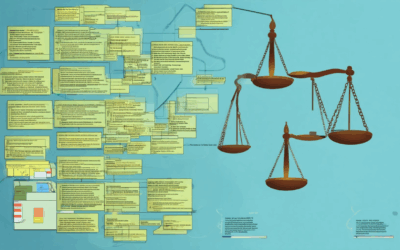In the intricate landscape of nonprofit operations, accountability stands as a cornerstone of trust and effectiveness. As organizations strive to serve their missions, adhering to high standards of accountability ensures transparency, efficiency, and alignment with donor expectations. Nonprofit accountability practices play a pivotal role in fostering trust among stakeholders, ensuring that funds are utilized responsibly, and maintaining ethical practices. This article delves into the critical aspects of nonprofit accountability, exploring its significance, mechanisms, and real-world applications to provide actionable insights for enhancing organizational performance and public trust.
Key Takeaways
– Nonprofit Board Accountability: The nonprofit board is responsible for effective governance, strategic planning, financial oversight, compliance, stakeholder communication, risk management, and continuous improvement to ensure mission alignment and trust.
– Legal Accountability: The board is collectively responsible for the organization’s actions, though individual members may not face personal liability unless proven negligent.
– Fiduciary Responsibility: Board members, executives, and volunteers must act in the organization’s best interest, avoiding conflicts of interest, ensuring financial transparency, and adhering to ethical standards to maintain trust and effectiveness.
– Best Practices: Clear policies, regular audits, open communication, and seeking legal advice help fulfill fiduciary duties and enhance organizational success.

Accountability Standards for Nonprofit Organizations
The Accountability Standards® are a set of guidelines developed to ensure nonprofit organizations meet certain benchmarks in areas such as governance, financial management, fundraising, and public communication. These standards aim to foster trust and transparency between donors and nonprofits, ensuring that charitable funds are used effectively.
Why Are Accountability Standards Important?
Accountability standards play a crucial role in building credibility and trust among stakeholders. By setting clear expectations, nonprofits can demonstrate their commitment to ethical practices, which in turn strengthens relationships with donors, volunteers, and the communities they serve.
Key Components of Accountability Standards
- Governance: Ensuring the organization has a board of directors that oversees operations and holds leadership accountable.
- Financial Management: Providing clear guidelines for budgeting, accounting, and reporting to ensure funds are used appropriately.
- Fundraising Practices: Establishing ethical methods for raising money, including clear disclosure of how donations are used.
- Public Communication: Requiring accurate and transparent reporting to stakeholders, including annual reports and financial disclosures.
Development Process
The Accountability Standards are not static; they evolve through a collaborative process involving stakeholders, including donors, volunteers, and experts in the nonprofit sector. This ensures that the standards remain relevant and effective in addressing contemporary challenges faced by nonprofits.
Benefits of Adhering to Standards
- Better relationships with donors due to increased transparency.
- Improved operational efficiency and effectiveness.
- Stronger reputation and brand loyalty among stakeholders.
- Easier access to funding sources and partnerships.
Conclusion
Accountability standards are vital for nonprofit organizations to maintain trust and integrity. By aligning with these benchmarks, nonprofits can enhance their missions and achieve greater impact. The continuous evolution of these standards ensures that nonprofits remain responsive to the needs of their communities and uphold the expectations of their stakeholders.
What is the 33% Rule for Nonprofits?
The 33% rule, also known as the public support test, is a requirement for U.S.-based nonprofit organizations that qualify as tax-exempt under Internal Revenue Service (IRS) Section 501(c)(3). This rule ensures that these nonprofits receive adequate public support to maintain their tax-exempt status.
To satisfy the 33% rule, at least 33.3% of the total contributions (as measured by dollars or equivalent value) must come from donors who contribute $ or its equivalent to 2% of the organization’s total receipts. This means:
- At least 1/3 of donations must come from contributors whose individual contributions are less than 2% of the organization’s total receipts.
- Exceptions apply for gifts received from other public charities and government sources, such as grants or contracts.
Nonprofits must maintain records to verify compliance with the 33% rule. Failure to meet this requirement can result in loss of tax-exempt status. Proper documentation and adherence to IRS guidelines are essential for maintaining trust with donors and ensuring continued qualification for tax benefits.
For further details on understanding the public support test and IRS guidelines, explore our comprehensive resources on nonprofit compliance and fundraising strategies.

What Are Two Mechanisms for Nonprofit Accountability?
Nonprofits are held accountable through various mechanisms that ensure transparency, integrity, and effectiveness in their operations. Here are two primary mechanisms:
Governance and Oversight Structures
- Board of Directors: A well-structured board oversees organizational strategy, ensures legal compliance, and holds leadership accountable. They may also hire external auditors.
- Independent Audits: Regular financial and operational audits by third-party experts provide unbiased evaluations of the organization’s performance and fiscal health.
Programmatic Accountability
- Outcome Measurement: Nonprofits track program impacts using measurable goals and indicators to demonstrate effectiveness and justify funding.
- Stakeholder Feedback: Engaging donors, volunteers, and beneficiaries in feedback loops helps identify issues and improve service delivery.
These mechanisms work together to build trust, ensure ethical practices, and maximize community impact. By maintaining strong governance and continuously measuring outcomes, nonprofits can better serve their missions and communities. For further insights, explore compliance resources and impact measurement tools at NPO Expert.

Accountability of a Nonprofit Board
The accountability of a nonprofit board is rooted in its role as the governing body responsible for overseeing the organization’s operations, ensuring alignment with its mission, and maintaining trust among stakeholders. Below are the key aspects of a nonprofit board’s accountability:
1. Oversight and Governance
The board ensures the organization operates effectively and legally. This includes monitoring organizational performance, setting policies, and holding leadership accountable for achieving goals.
2. Strategic Direction
Board members are responsible for developing and approving the organization’s strategic plan. This plan outlines the nonprofit’s goals, objectives, and approaches to achieving its mission over a specified period.
3. Financial Oversight
A critical responsibility is overseeing the organization’s finances. This includes reviewing budgets, ensuring funds are used appropriately, and maintaining transparency in financial dealings. The board also ensures compliance with reporting requirements and avoids conflicts of interest.
4. Compliance and Legal Requirements
Nonprofit boards must adhere to federal, state, and local laws, including those related to tax-exempt status, fundraising, and program delivery. The board ensures the organization meets all regulatory obligations.
5. Stakeholder Communication
Effective communication with donors, volunteers, and other stakeholders is essential. The board ensures that the organization’s activities align with the expectations of its supporters and maintains open channels for feedback.
6. Fund Development
While not always explicitly stated, the board plays a key role in securing resources. This may involve strategic planning for fundraising campaigns, cultivating major donors, and ensuring diversification of funding sources.
7. Risk Management
The board is responsible for identifying potential risks, such as legal, financial, or operational challenges, and implementing strategies to mitigate these risks. Proactive risk management ensures the organization remains sustainable and resilient.
8. Evaluation and Continuous Improvement
Regular self-evaluation helps the board assess its performance and identify areas for improvement. This process ensures the board remains effective and aligned with the organization’s needs.
9. Ethical Standards
Board members must uphold high ethical standards, avoiding conflicts of interest and ensuring that decisions are made in the best interest of the organization and its beneficiaries.
By fulfilling these responsibilities, the nonprofit board ensures the organization operates efficiently, stays mission-driven, and builds lasting trust with its stakeholders.
Who is Legally Accountable for a Nonprofit Organization’s Actions?
The legal accountability for a nonprofit organization’s actions primarily lies with its governing body, the board of directors. This group is responsible for overseeing the organization’s operations, setting policies, and ensuring compliance with applicable laws and regulations. However, the level of personal accountability for individual board members varies depending on the circumstances and state laws.
Key Points:
- The board of directors is collectively responsible for the organization’s actions, including compliance with legal requirements.
- Individual board members may not be held personally liable unless proven guilty of negligence or breach of duty.
- State laws often dictate the extent of liability, varying by jurisdiction.
For example, in California, the board’s liability is generally limited to their governance roles, whereas in New York, stricter laws may hold directors more accountable under certain conditions. Understanding these nuances is crucial for effective nonprofit management and risk mitigation.

What is a nonprofit fiduciary responsibility?
A nonprofit fiduciary responsibility refers to the legal and ethical obligation of individuals involved in a nonprofit organization to act in the best interest of the organization and its stakeholders, rather than in their own self-interest. This duty is fundamental to maintaining trust, accountability, and effective governance within the nonprofit sector.
Key Aspects of Fiduciary Responsibility in Nonprofits
- Definition of Fiduciary Duty
Fiduciary duty requires that those in positions of power, such as board members, officers, and senior leadership, prioritize the organization’s mission and goals above personal gain or external pressures. This includes decisions about finances, operations, and programmatic activities. - Roles Subject to Fiduciary Duty
- Board Members : As stewards of the organization, board members are legally obligated to exercise reasonable care and judgment in their actions.
- Executives and Senior Leadership : These individuals must align their decisions with the organization’s objectives and ensure transparency in their actions.
- Volunteers and Advisors : Even volunteers may be held to a standard of fiduciary responsibility depending on their influence or control over organizational matters.
- Duties Under Fiduciary Responsibility
- Act in good faith and with due diligence.
- Avoid conflicts of interest, where personal gain improperly influences decisions.
- Disclose potential conflicts of interest and seek approval from the appropriate governing bodies.
- Ensure the organization operates in compliance with laws and regulations.
- Examples of Fiduciary Breach
- Misusing funds for personal gain.
- Ignoring red flags or failing to investigate suspicious transactions.
- Making decisions that favor personal interests over the organization’s needs.
- Best Practices for Maintaining Fiduciary Responsibility
- Establish clear policies and procedures for decision-making and financial oversight.
- Conduct regular audits and evaluations to identify potential risks.
- Encourage open communication among board members and stakeholders.
- Seek legal counsel when unsure about ethical dilemmas.
Conclusion
Understanding and fulfilling nonprofit fiduciary responsibilities is critical to building trust and ensuring the long-term success of the organization. By acting with integrity and focusing on the organization’s best interests, fiduciaries contribute to the overall effectiveness and impact of nonprofits in serving their communities.





0 Comments